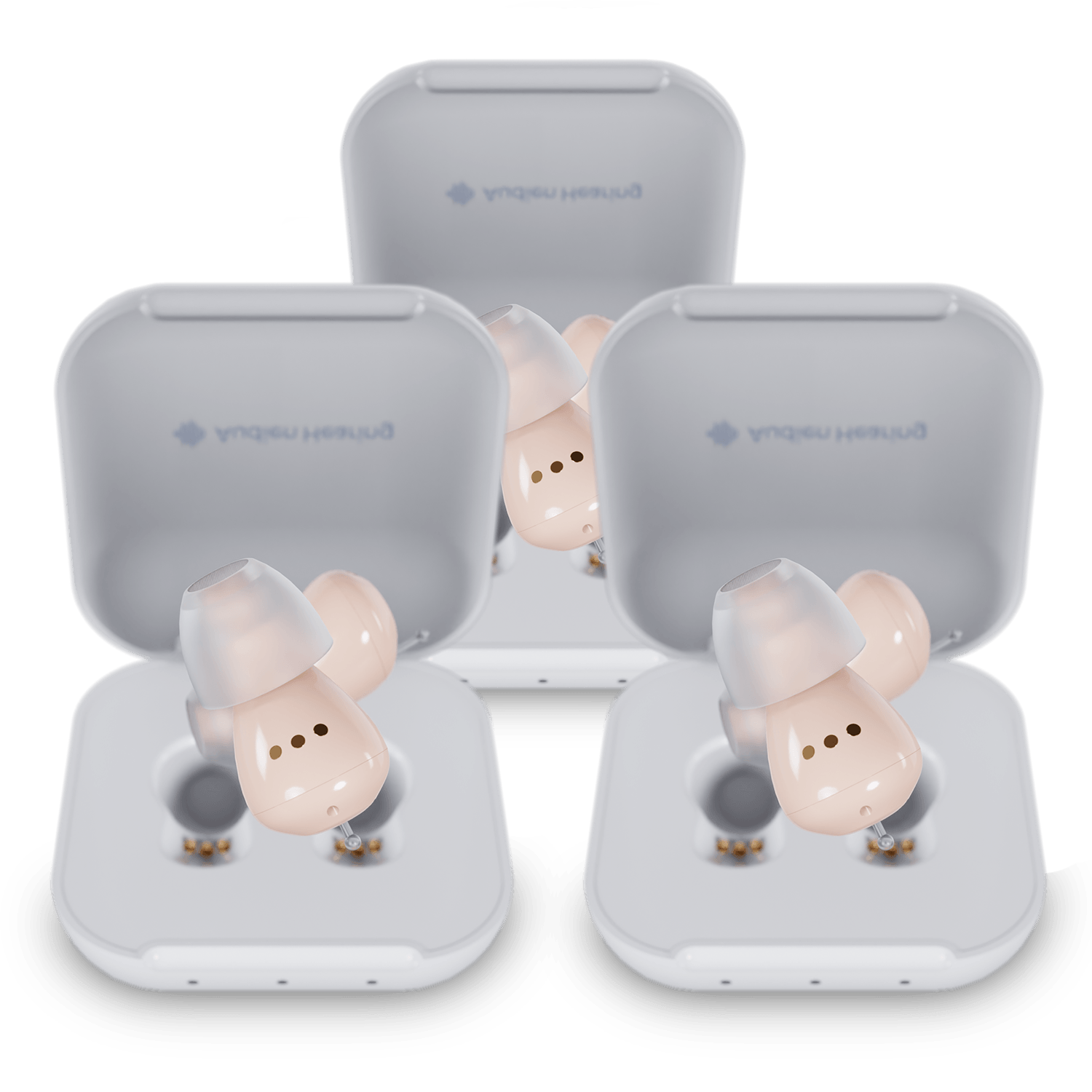In today’s world, we often take many of the things in our everyday life for granted and don’t take the time to understand where they came from and what life was like before we had them. Electricity, for instance, revolutionized our world and allowed for vast improvements in quality of life.
One item that many people utilize on a daily basis is hearing aids. These devices allowed those with hearing loss to live a fairly normal life by allowing them to hear sounds they would otherwise be unable to hear.
The hearing aid has not always been around. Below is a closer look at everything you need to know about hearing aids, including who invented hearing aids, how they work, and the many kinds of hearing aids available today.
The History of the Hearing Aid

When you look at a hearing aid today, it is largely a product of innovations of the modern technological era. The ability to manufacture technology in a small footprint has even allowed some hearing aids such as the Audien Atom to rest fully in the ear canal. This makes them nearly invisible to other people.
While the small-sized earbud type hearing aids are what you most likely associate with hearing aids, devices to help those with hearing loss have not always been compact or discrete. Below is a closer look at the many iterations of hearing assistive devices that have been utilized throughout human history and how they worked.
Ear Horns
One of the earliest forms of assistive hearing devices was quite large and cumbersome. Known as ear horns, these devices were essentially large cones that condensed down into an opening about the size of the ear canal.
The use of ear horns was most likely inspired by the tendency of people to cup their ears to hear more effectively, except these devices took that concept to a whole nother level. It is believed that ear horns have been utilized since the 17th century. In a historical context, this is the century that the pilgrims arrived in America on the Mayflower and when Issac Newton published his findings on gravity.
Ear horns essentially act like a satellite dish for your ears by focusing the sound on your eardrum. While these devices could be helpful in certain situations, they were cumbersome and also amplified all of the noise present in the environment.
Because of these factors, they were not really a practical option to utilize all day. They were only used when absolutely needed.
Over the years, a number of variants of the ear horn were created to allow them to have better usability. Some products that utilized the same methodology of ear horns included conversation tubes and auricles. The latter of which provided a hands-free option, albeit a funny-looking one.
Carbon Microphone
The next step toward modern hearing aids wouldn’t occur until well over a hundred years after the first utilizations of the ear trumpet. The evolution of hearing assistance was utilizing devices that utilized the power of electricity to amplify sounds.
Carbon hearing aids were the earliest form of non-acoustic hearing aids. They worked thanks to the use of the carbon microphone. This device allowed sound waves to be translated into an electrical impulse that could then be utilized to power a speaker and emit the same sound.
These forms of hearing aids were not the most practical and had to be placed on the table for the individual to hear. The devices were much smaller than the ear horns they replaced, but they still were a long war from the hearing aids we have today.
Vacuum Tube Hearing Aids
Just a few years later, the vacuum tube hearing aid was created. The name comes from its utilization of vacuum tubes to help amplify sound. Vacuum tubes were the beginning of the electronics we know today. These advancements allowed hearing assistive devices to be smaller.
They were still not as portable as they are today. The vacuum tubes themselves were quite large; the batteries required to power them were also not incredibly portable.
Many vacuum tube hearing aids were multi-piece, meaning they were not all one unit. Each component was connected by wires. Typically these components consisted of an earpiece, a battery pack, and the microphone/amplifying unit.
Transistor Hearing Aids
Around the middle of the 1950s, transistor hearing aids started to emerge. Transistors can be thought of as a more power-efficient and smaller version of vacuum tubes. Notably, these electrical components required less energy.
This allowed for the use of smaller batteries which then made these types of hearing aids more portable. Pair this with the innovation of battery technology, and hearing aids began resembling much of what they do today.
Since the mid to late 50s, the basic setup for these hearing aids has stayed relatively the same. Since then, notable improvements have been made along the way to provide better microphones, better speakers, smaller hardware, and clearer sound.
Who Invented the Hearing Aid?
With a general understanding of the history behind hearing aids, you may wonder who exactly is credited for creating the first hearing aid. While it would be nice if there was a straightforward answer, the truth is that the hearing aids you know today come as the result of countless innovators.
These brilliant minds invented individual components that allow hearing aids to work. From the battery that supplies electricity to the microphone that is able to pick up sounds, hearing aids are truly a joint effort of hundreds of people throughout history.
While the invention of the hearing aid owes thanks to many inventors throughout history, one that stands out is Miller Reeser Hutchison. Hutchinson was the individual who created the first electrical hearing aid. His design paved the way for the future of hearing aids.
Created in 1898, the device would soon inspire others to create their own rendition of the device. This ultimately led to the innovation we know today.
Modern Hearing Aids

Now that you have a thorough understanding of the leaps and bounds made in hearing aid technology, you may wonder how these tiny devices are able to accomplish such amazing results in such a small package.
Below is a closer look at how modern hearing aids work as well as the different kinds of hearing aids available.
In-Ear Hearing Aid
In-ear hearing aids are some of the most popular options available today because they pack a powerful punch in a tiny package. In-ear hearing aids are hearing aids that are entirely placed within the ear canal. This makes them near invisible to others when they are being worn.
With in-ear hearing aids, the speaker, microphone, and amplifier are all placed into the ear canal. These aids eliminate the need for an external component of the earpiece which may be undesirable to some.
Traditionally in-ear hearing aids were priced well above the threshold for the everyday joe to afford, but luckily Audien is making waves through the industry by providing this technology at a shockingly reasonable price point. With the EV1, EV3, and Atom series of hearing aids, you can find the best option that fits your needs and your budget.
Behind the Ear Hearing Aid
The traditional, modern hearing aid that most people are familiar with is known as a behind-the-ear hearing aid.
Rather than having everything neatly tucked away in the ear canal, the behind-the-ear hearing aid design allows the battery, amplifier, and microphone to sit behind the outside of the ear. The speaker still goes into the ear canal, but a large majority of the device is external.
While these are still used by many, at the rate of technological advancement, don’t be surprised if this design completely phases out in favor of in-ear hearing aids in the future.
Bone Conduction Ear Hearing Aid
Up until this point, the hearing aids discussed have still utilized air as a medium of getting louder sounds to your ear. However, this doesn’t work in all cases of hearing loss.
Some people may have hearing loss that doesn’t allow their middle ear to work properly. As a result, standard hearing aids won’t work as well.
Bone conduction hearing aids are essentially the same as normal hearing aids. Rather than outputting the electrical signals from the amp and microphone to a speaker, they are output to a device known as an oscillator. An oscillator is an electrical component that vibrates when electricity is applied.
The oscillator is either making contact with the bone behind the ear or directly attached to the bone through surgery. This allows the vibrations to reach the inner ear for you to hear.
The Past, Present, and Future of Innovation
Hearing aids have truly changed the lives of those that are hard of hearing. Whether you were born hard of hearing or developed it over time, hearing aids can allow you to live a fairly normal life full of hearing.
The hearing aids available today hardly resemble those throughout history. The continual progress made in science and technology has allowed people today with hearing loss an option that is immensely capable.
Sources
The Hearing Aid Museum | Hearing Aid Museum Gallery
Miller Reese Hutchison - Newspaper Clippings | Birmingham Public Library Digital Collections













